A well-crafted business proposal should grab the reader’s attention immediately and make them want to read your entire business plan; this is because there are instances where investors or sponsors make an early judgement and decision based on your business plan. Therefore, it is mandatory to write a great executive summary. By definition,
An executive summary is a synopsis and/or a brief introduction of your business strategy.
It helps to describe your business, the problems identified in the market and the possible solutions your business will provide, your target audience, and the business’s financial highlights. Moreover, this summary highlights the important sections and information in the main business plan document to the readers.
Therefore, if you are planning on impressing your potential investors or sponsors, it is necessary that you craft a perfect summary that not only helps you over the investors but also highlights the key information contained in the rest of the proposal.
Notably, it can also be used in an already established organization. The executive summary plays a huge role in the formulation and presentation of a new strategic plan or a yearly operations scheme by emphasizing on the important points that are contained in the overall proposal.
Free Templates

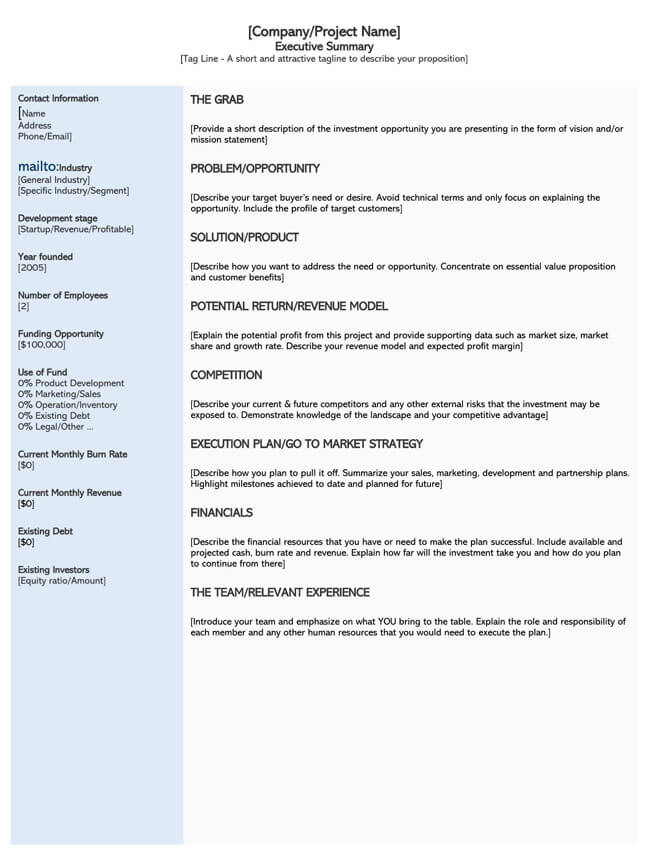
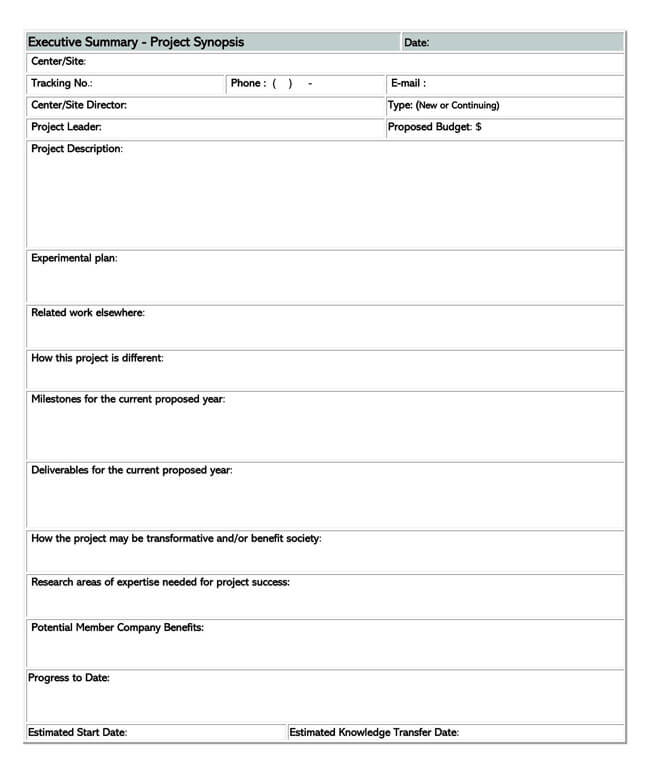
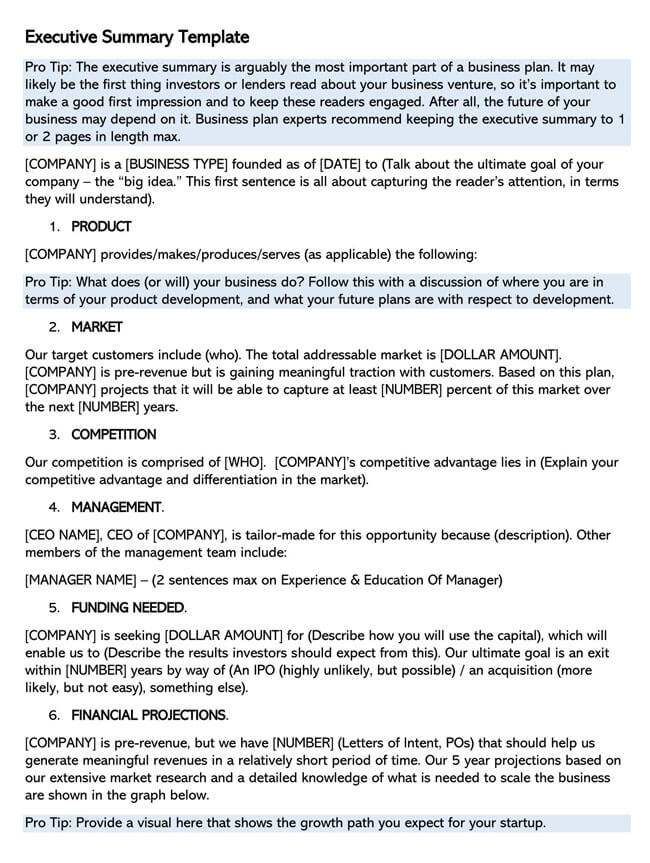
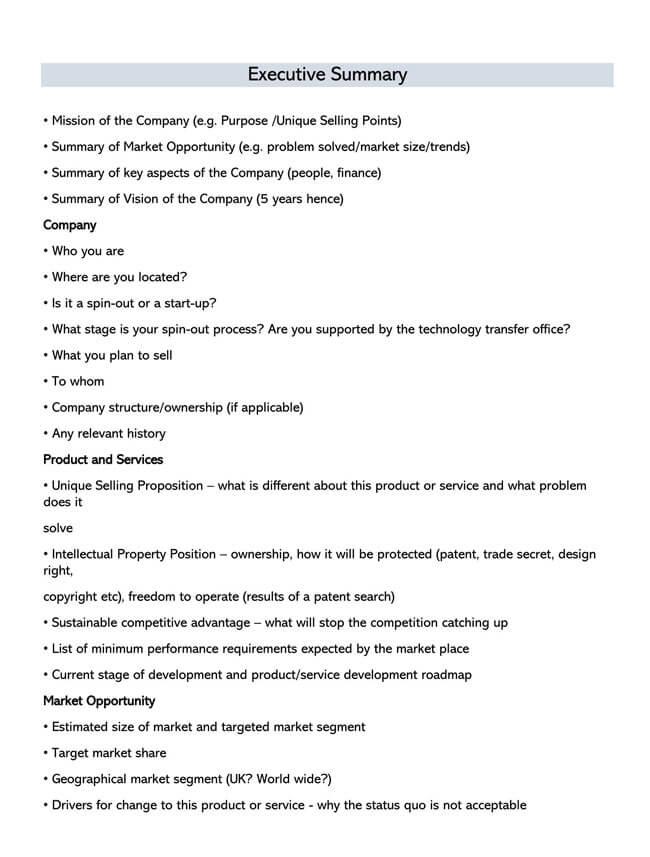
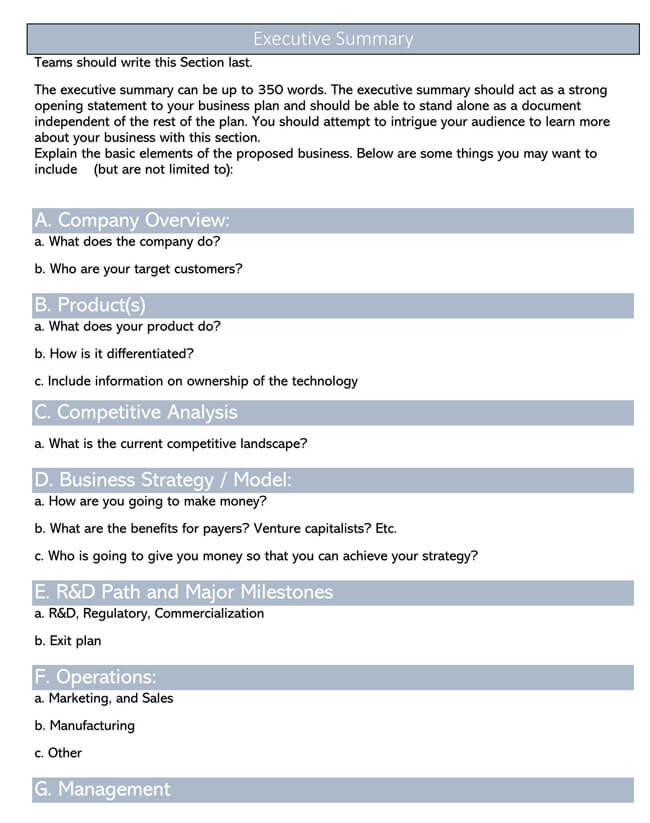
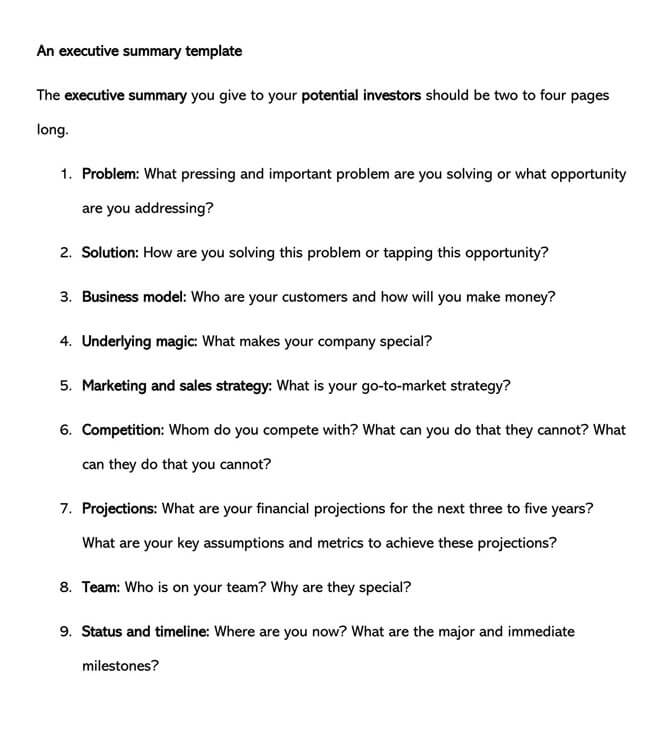
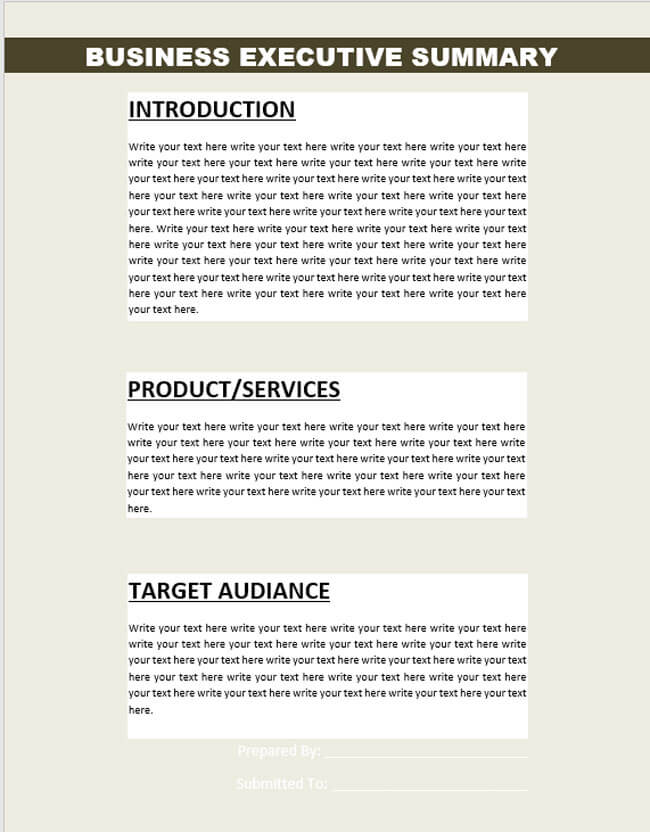
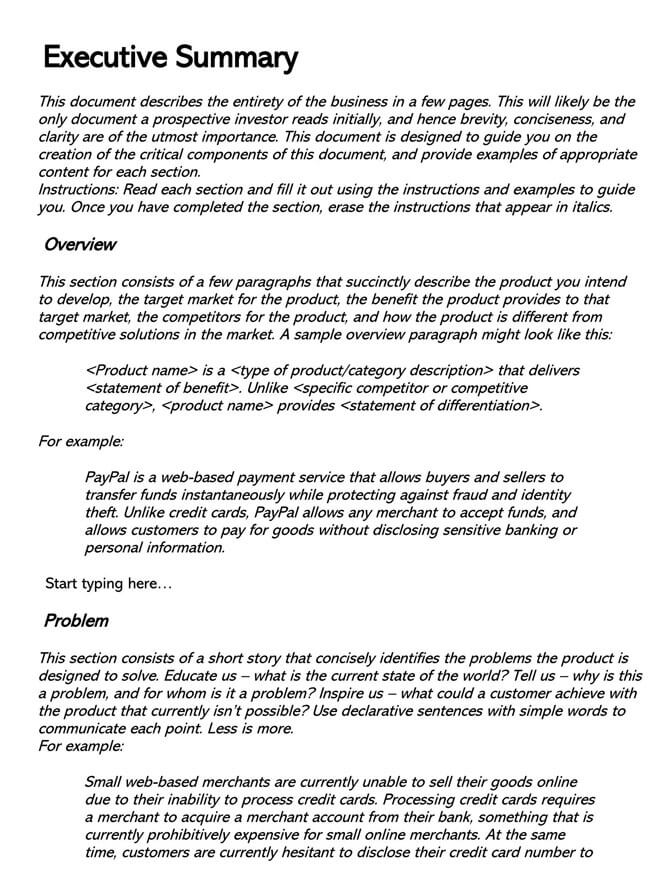
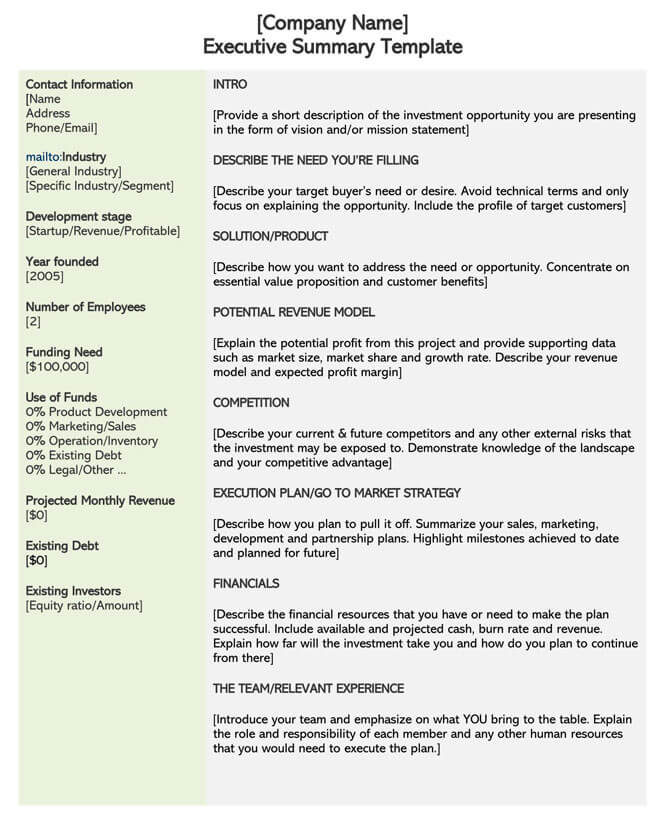
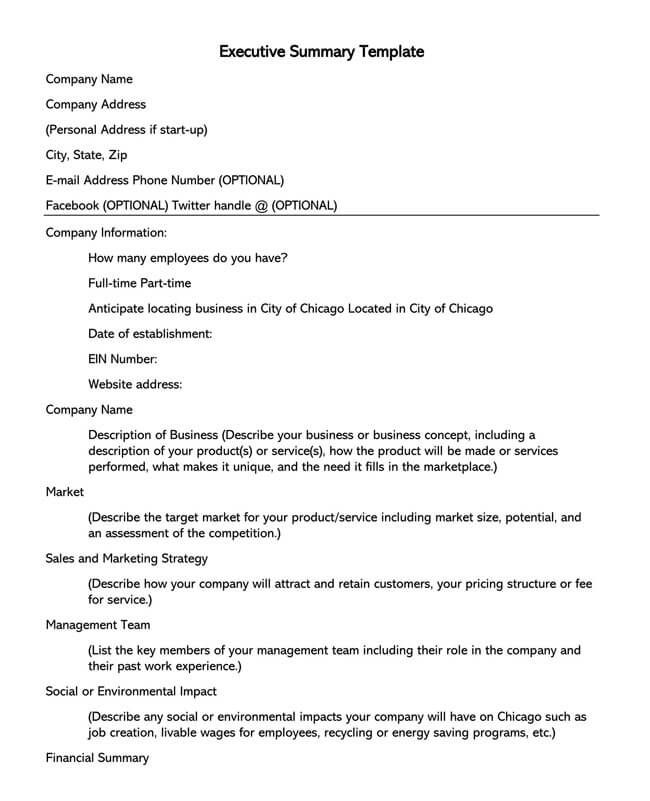
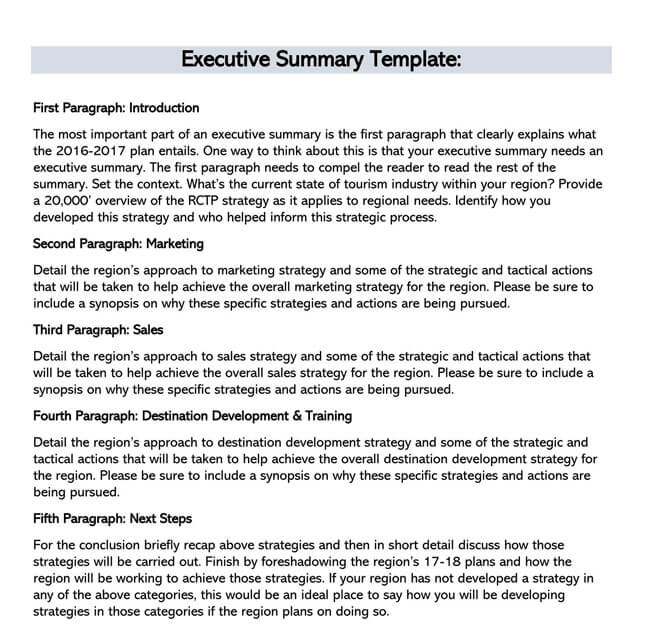
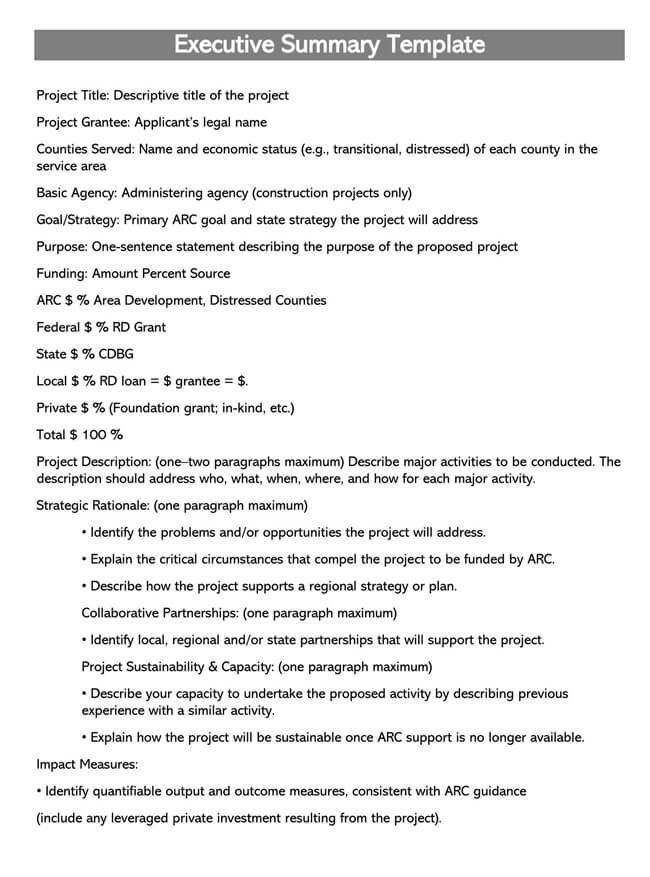
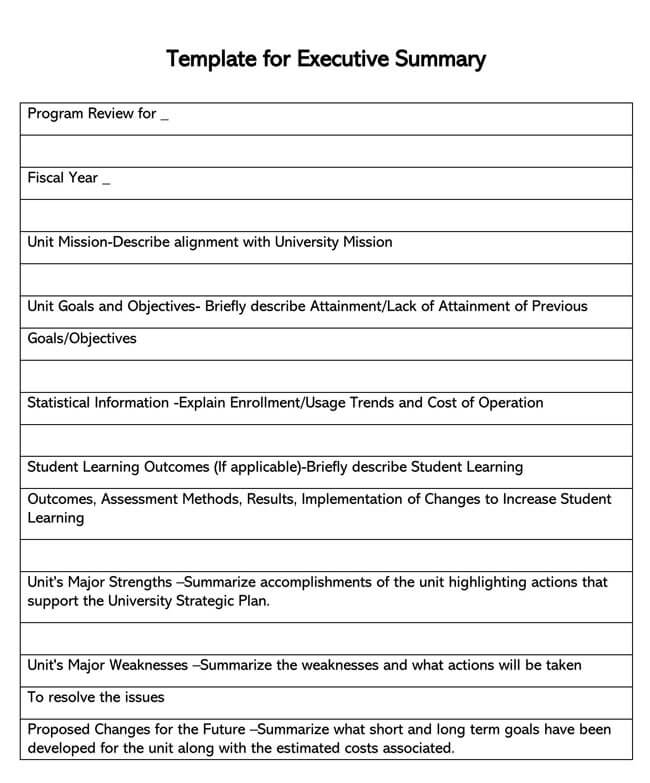
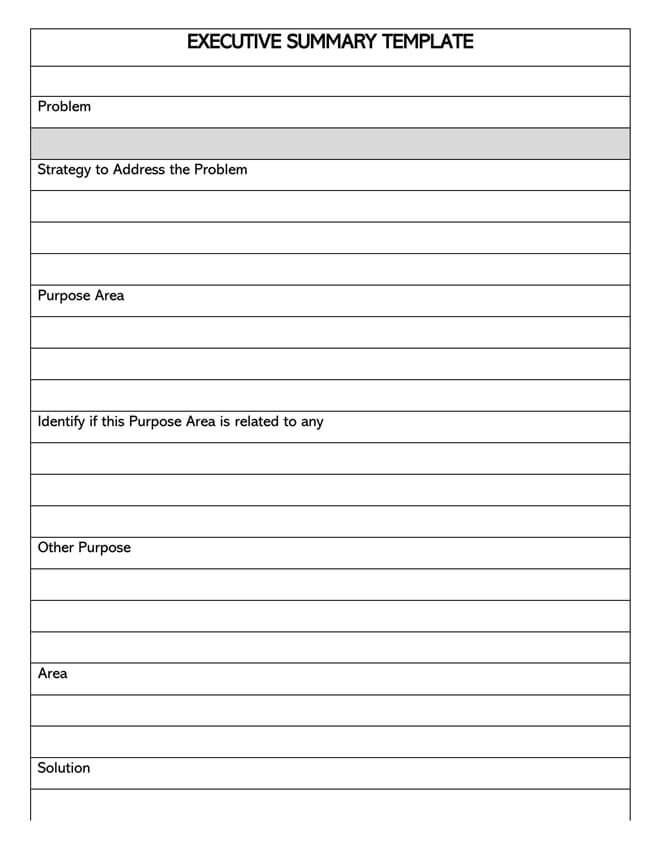
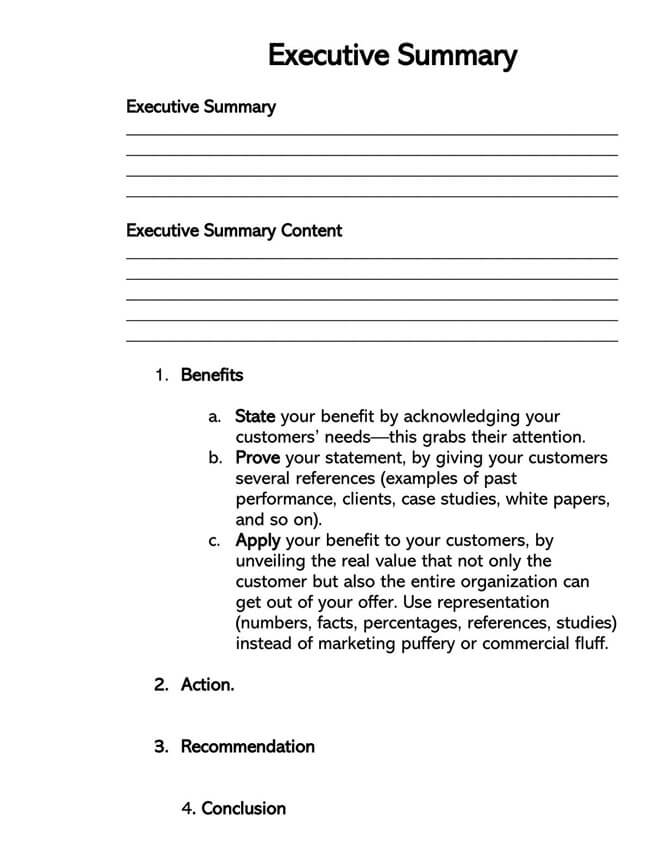
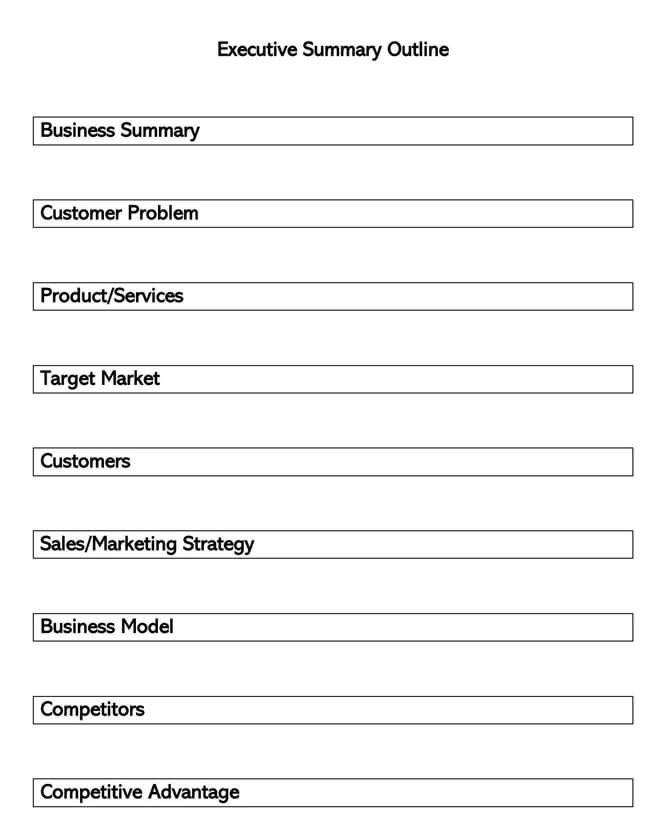
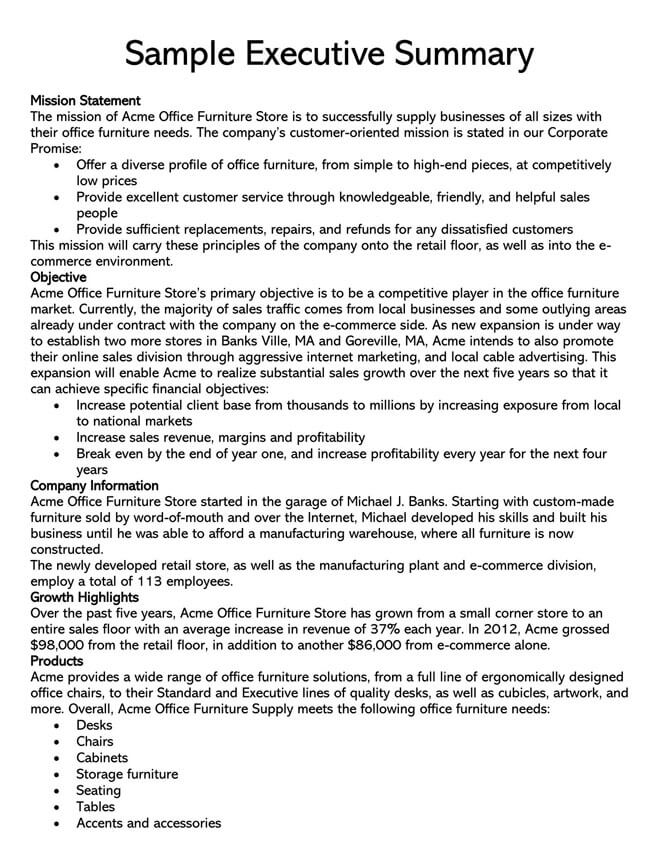
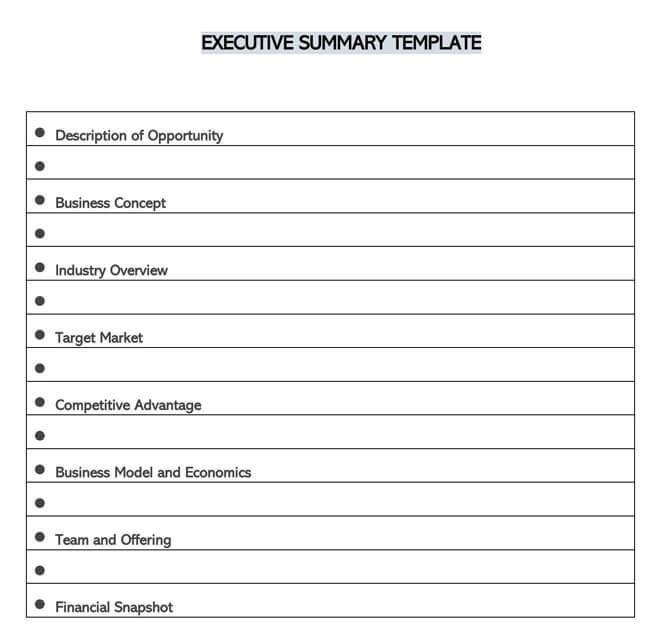
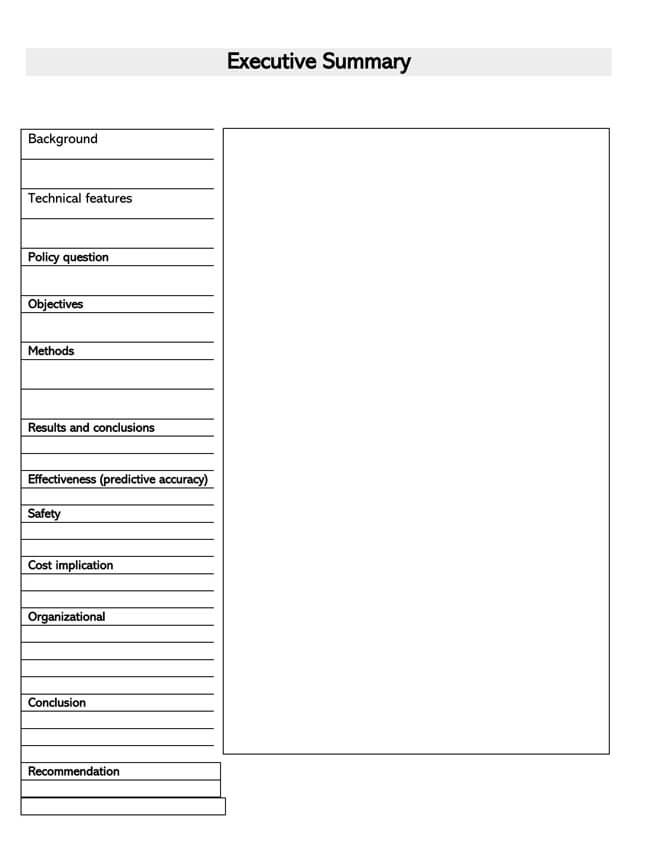
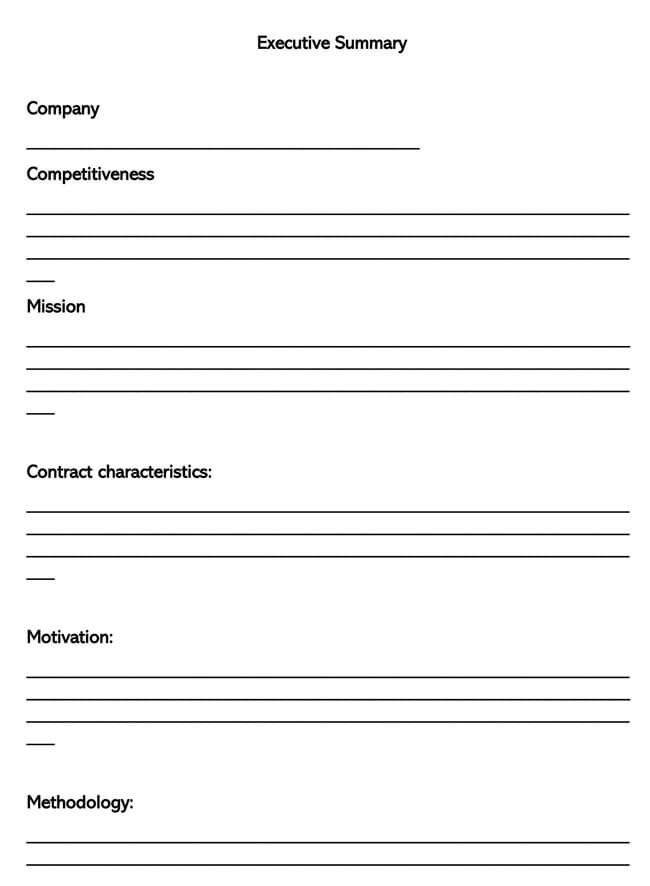
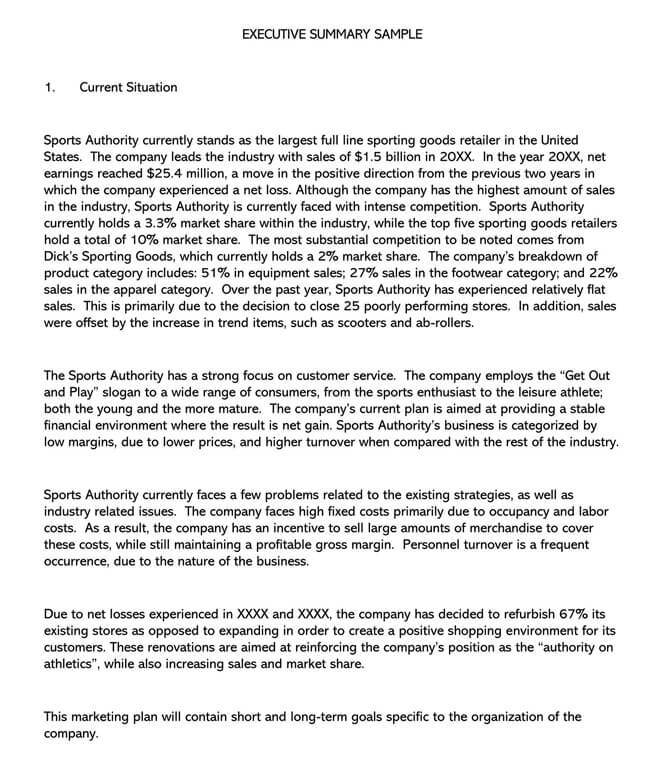
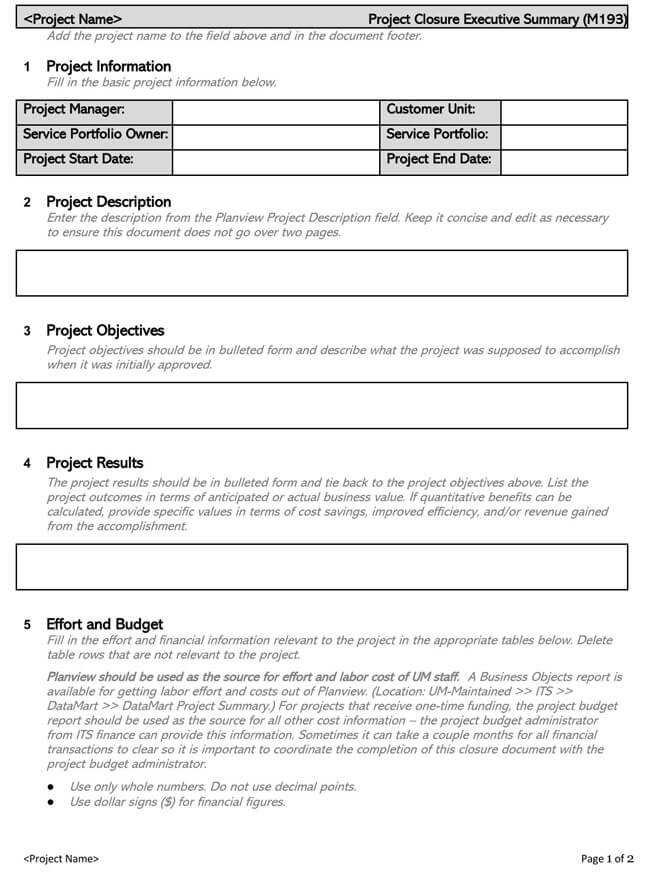
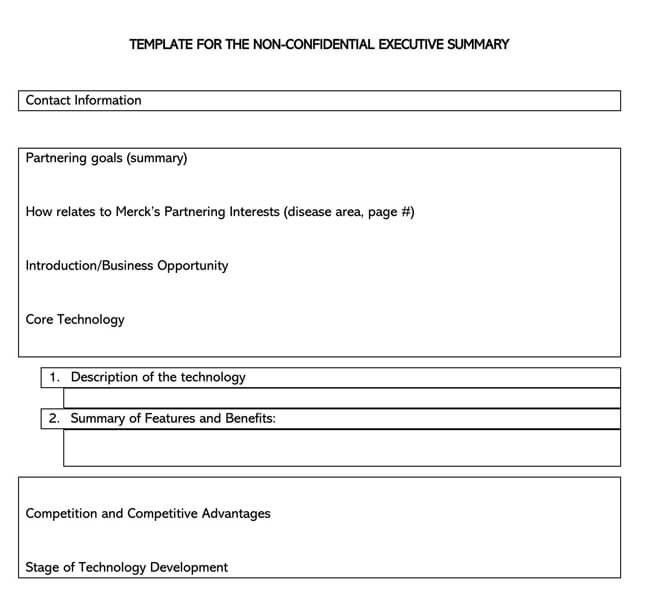
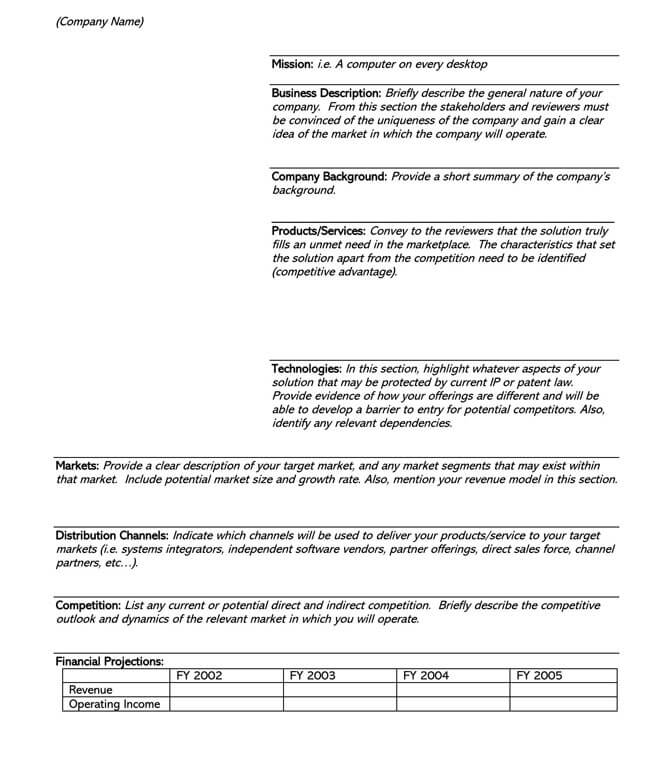
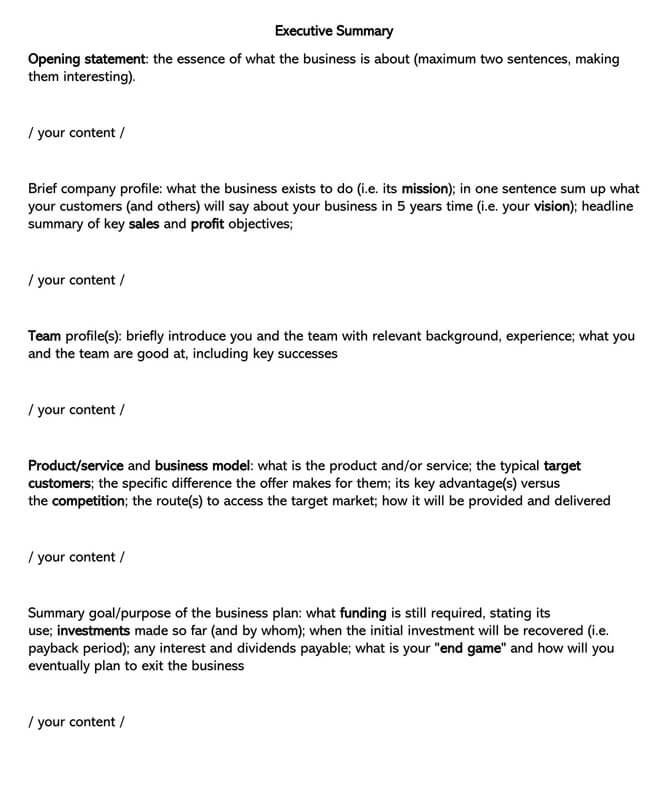
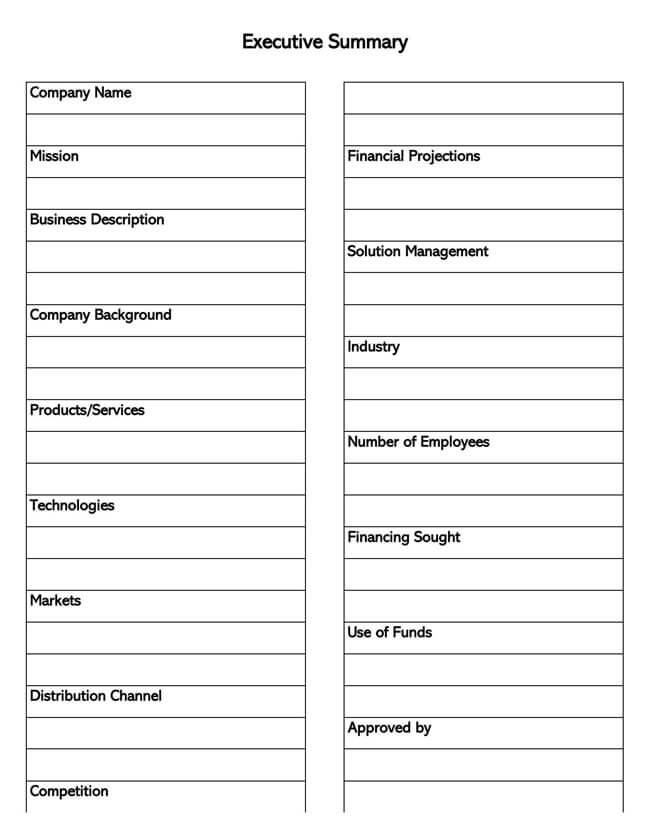
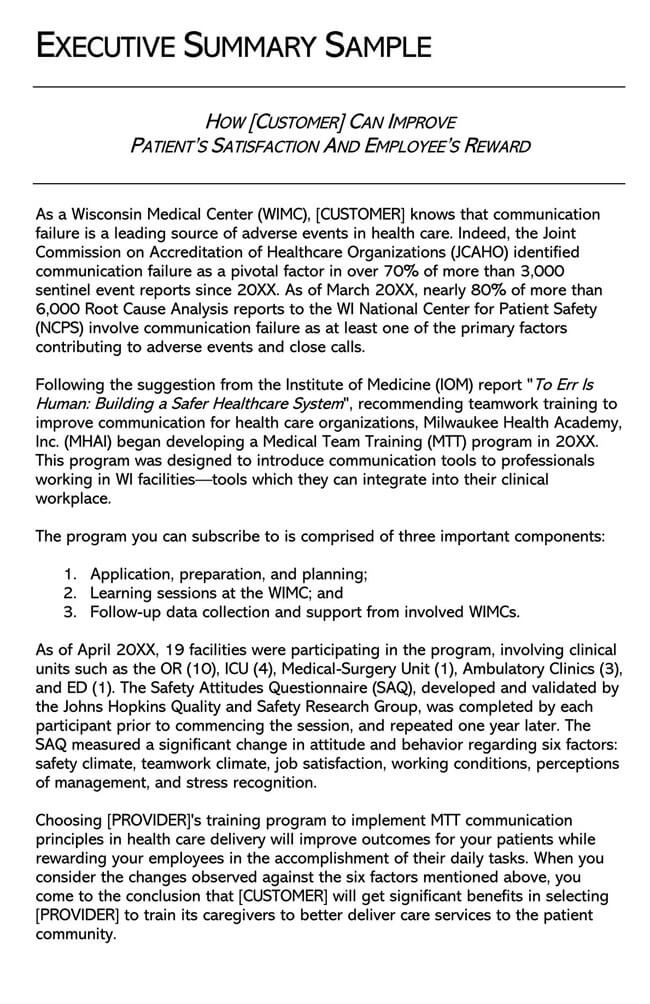
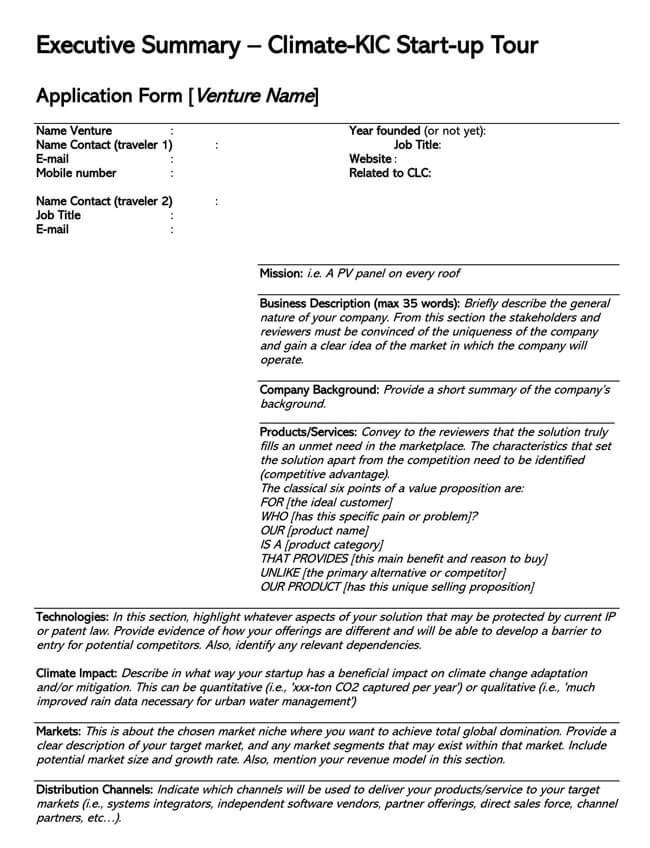

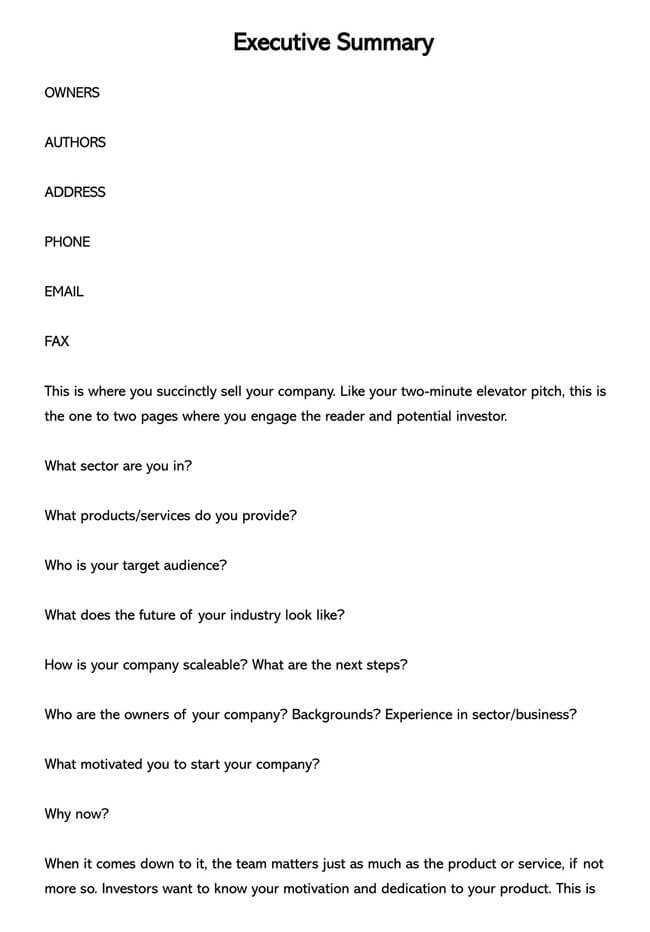
Executive Summary Format
Most businesses will have different business plans. Therefore, your summary will heavily rely on the purpose of your business objectives.
Here is a basic format for any executive summary:
- Introduction– Your introduction should be direct to the point. It should state and describe the main purpose of the summary.
- Need– It is mandatory to identify a need or a problem in the market that your proposal will solve; this will help capture the attention of the investors or sponsors into reading or considering your business proposal.
- Solution– Once you have identified a problem, provide an implementable and working solution. By doing this, the investors will be interested in reading more of your summary. As a result, this will boost your credibility.
- Proposal– Provide the investors with the idea of what your business is all about. The this summary should pinpoint a problem in the current market and highlight the best solutions to those problems.
- Conclusion– provide a short and informative conclusion; this will help you leave an impression and urge the investors to read more. In most cases, this part is always a paragraph in length.
Writing an Executive Summary
It is important to have the potential investors and stakeholders in mind when you are developing an executive summary; this is because most of them will want to get a detailed overview of your business proposal.
Therefore, you will have to break down the business plan into several detailed paragraphs to explain your business plan’s main points extensively.
Executive summary for a startup business
The main aim of those intending to set up a new business is to acquire the startup capital. Therefore, regardless of how you get the finances, it is necessary to make a great impression for your business by writing and capturing captivating information in your summary.
Below is how you can write this summary for startup businesses:
- Discuss the business opportunity– To start with, provide a summary of the problem your business is intending to solve in the current market.
It is important to briefly elaborate to the investors the problem you have identified and propose the best ways that you think your business will solve them. Ensure that your business description is clear and straight to the point to avoid boring your potential investors. - Tell how your startup will take advantage of that opportunity– Clarify how your business will influence and improve the market. It is necessary that you provide strategies and ways in which your business will help in solving the problem that you have identified in the market.
Additionally, identify the resources that you require in order to adequately solve the identified problem. - Explain your target market– Describe your target audience in detail. It is obvious that no matter how good your business proposal is, without an appropriate market, the idea is considered useless.
Therefore, introducing your target audience to your investors is really important. It is necessary for them to understand who you are targeting, their needs, and how to get to them. - Clarify the business sales and marketing– Explain the marketing strategies you will employ when running your business. Any business striving to build its reputation and retain its relevance in the market has to employ sales and marketing strategies that will propel their sales.
Therefore it is mandatory to ensure that you brief your investors on the marketing and sales tactics that will help your business proposal become a reality and beneficial at the same time. - Discuss your business model– Give a rough idea of the products and services you will offer and why they will attract your target market. In this stage, you will show and explain to your potential investors the plans that you have that will make your business a success.
Without a concrete business model, most investors will disregard your proposal. Therefore, you will have to provide the investors with your revenue plan, your vision and mission and introduce your team. - Provide a financial analysis– Briefly provide and explain your financial strategies. The financial information you provide in your summary will be a way to find out the level of interest of the investors.
Therefore, highlight your current financial state, the financial support that you need, and the profit margin your business is likely to generate. While doing this, keep in mind what is as stake. - Describe your management team– Give a brief description of your team, their qualities, and skills. Explain why you chose them and the value they will add to your business.
A qualified team will make it easy for the business to grow and gain relevance in the market. Presenting a well-trained and qualified manpower to the investors will help you win them over with ease. - Provide an implementation plan– Provide the key steps on how you and your team will take the business idea and create an actual business out of it. In most cases, the investors are interested in knowing how the business proposal will be actualized. It is important to have a well-organized and workable implementation plan that will oversee the birth of a successful business.
Executive summary for established business
An executive summary’s main aim in this stage is to highlight the organization’s accomplishments, development plans, marketing strategies, etc.
- State the company’s mission– State and explain the main objective of the business.
- Provide some company information– Briefly describe what the organization does, its location, the number of employees, the products and services it offers, its geographical location, and its statistics.
- Highlight the achievements– Provide a brief history of the organization, the growth of the business over the years, show who your regular and potential clients are, the profits you make, and the market share you own.
- Include a financial summary– Briefly show how the business earns its profits, how it spends the earned revenue, and its investments; this may prove very important, especially when applying for a loan.
- Describe the company’s future goals– What is the company planning to achieve in the near future. Show who the key players are in this plan and who is targeted by this plan.
Executive summary for marketing proposal
The main aim of a marketing proposal is to allow the potential clients to see beyond the marketing strategies employed and the finances involved in the whole plan. The main purpose is to see how the business will turn out.
Additionally, the summary will provide the client with what to expect both from the business and working with you.
Below are the steps to be followed when preparing an executive summary for a marketing proposal:
- Introduction– Provide a brief explanation of what the project is all about and the main objective of the marketing plan.
- Company information– Give a summary of the company’s history, its objectives, its structure, and the clients it targets and serves.
- Project management team– Provide information of all the key individuals in the management team, their qualities, skills, and the role they play in realizing the organizational goals.
- Market analysis– Briefly describe who you are selling to, the marketing strategies you employ, the current trends in the market, what is influencing these trends, and how they affect your reputation and credibility.
- Products and services– Describe the Unique Selling Propositions (USPs) for the products and services you are offering. Moreover, provide an analysis of the competitive advantage they bring to the organization.
- Marketing strategy– Point out and describe who your potential clients are and how to meet and satisfy their demands easily.
- Financial planning and projections– Provide a brief financial statement that breaks down both the long and short-term financial and marketing activities. Additionally, it will provide data on the prospected budget and the projected Return on Investment (ROI).
- Goals– Break down the aims of the advertising promotion and the approaches that will lead to the business’s success.
Executive summary for a report
Another important use of the executive summary is as a prologue for a report. In this case, this summary will provide you with a breakdown of the information found in the report. It includes the objective, methodology, and major findings of the report.
With this summary, you as the reader can establish and understand what is in the report before even reading the actual report.
Below are the steps that you can use to write an executive summary for a report:
- Write an opening statement– You should provide a short but detailed background on the scope of the report. In this phase, you will be required to briefly introduce and explain the subject covered in the report. By doing this, the reader will have an idea of what the full report is all about.
- Explain the purpose of the research– Point out the objectives of the study you have discussed in the report. This step will succinctly point out the main purpose of the report by highlighting the main objectives of the report.
- Highlight the methodology– Here, discuss the methods that have been used in the report to gather data and the analysis techniques employed. You will be required to point out all the methods that you used to gather data and show what you used to examine the collected data.
- Outline the key findings– When it comes to key findings, elaborate on the outcome of your study and the major takeaways that you would like your readers to know. Additionally, break down the findings in such a way that you only highlight the key points; this will make it easy for the readers to relate and understand what your report is talking about.
- Describe your recommendations– Write the recommendations you made in the report, and you can also add some justifications of the points you have made. In order to justify your points, it is necessary that you provide a brief elaboration of what your future recommendations are depending on the subject that you have covered in your report.
Supplementary Topics to Cover
These are extra details that your summary might need to cover or have as you prepare it.
Evidence of early success
In case you are a young business and are preparing a business plan, you may need to provide evidence of traction in your summary. This involves surveys from customers and sales numbers. You do not have to write much, but evidence of early success is proof enough to show that your business is doing well.
Evidence of early success also shows that your products, business type, and your research about the market are well-established.
Future milestones
It may also be wise to include what your business hopes to achieve in the future in your summary. Businesses with complex structures like drug companies may benefit by writing their plans or milestones in their summary.
You will need to mention your future agendas and establish where you are currently and how you plan to move further forward.
Evidence of financial stability
This is necessary when you want a loan from a bank or any other financial institution. In your summary, the bank might need evidence of financial stability like your finances, your money history, and assets before offering you a loan.
Do’s and Don’ts to Consider
Just like most documents, there are things to do and things not to do when writing them. For you to write an effective executive summary, here are some things you should observe. Stick to the do’s and steer clear from the don’ts to have a successful summary.
Do: Write a shining intro paragraph.
An executive summary is somewhat lengthy, and your potential client might not read the whole proposal. Therefore, you need a strong and shining introduction that will get the client’s attention and trigger him/her to read your summary.
A powerful introduction paragraph will ensure that even though the client decides to skim through your summary, he/she will still spot evidence of your confidence, skills, and abilities as you sell him/her your ideas.
Don’t: Steer clear of sweeping generalizations or false information.
Avoid all repetitive and overused statements. Do not use cliché statements. Try to use creative, unique, and honest information. Professional work makes the client excited and attracted to the plan of your executive summary.
Do: Provide a thoughtful aim to your audience.
After a powerful introduction, focus on tailoring your summary to address the client’s specific needs and issues. Try and offer well-researched and detailed information that directly addresses your client for you to grasp and keep their attention.
Even if you choose to use a template, ensure you edit it so that the client can relate to your work.
Don’t: Do not get technical.
Avoid in-depth explanations and technical language. Such language will not be able to grab your reader’s attention. Use simple language that will be attractive to the client and will push the client to read the whole summary.
Do: Offer up an identifiable goal.
Clients are mostly interested in the end goal or solutions more than their problems and how you plan to solve them. They appreciate what your results will be. You can focus on the returns or profits the client will make your executive summary more interesting.
Clients focus on the benefits they will achieve; hence, if you want your summary to be attractive enough for them, research the potential gains they will achieve.
Don’t: Do not get carried away
It might be exciting to write an executive summary. However, do not get carried away when writing one. Try and summarize your ideas in a way that captures the attention of your readers. A one-page summary might be more comprehensive than a 20-page one.
Do: Pay close attention to detail.
Avoid mistakes in your summary. Try and focus on the details of your proposal correctly. Ensure you check and edit any errors in your summary before you submit it. Any mistakes might make you look unprofessional and might not get your summary approved.
Don’t: Do not leave it till last.
Most of us might have been told that it is way easier to write an executive summary after finishing your report. However, do not be tempted to write your summary as the last thing. Write your summary first to avoid having to re-write new points that might emerge. This summary will act as a map and guide you as you make the actual report.
Do: Leave your company history in the past.
Mentioning your previous successes in your summary is not an issue. In fact, it helps to lure potential clients into being actual clients. However, an executive summary is not a place for you to start explaining your business’ or company’s history. Get straight to defining the problem, stating the goal, identifying the issues, and state the solutions. And by doing this, you save your and the client’s time.
Quick Tips for Your Executive Summary
Here are some professional tips that will help you in not only writing this summary but also representing it in front of the investors.
Writing tips
- As you prepare to write an executive summary, think of it as a pitch. It should be attention-grabbing and still powerful.
- Ensure you avoid writing your summary last to ensure you do not waste time changing your whole report in case of new content.
- Have a brief and precise summary. You do not want to bore your client even before he/she reads your full report.
- This summary should be simple. Avoid jargon and technical language.
- Ensure you prioritize your sections based on the importance and strength of the information
- You can also use your executive summary for your summary memo. Since this summary is a brief breakdown of what is in a report, it can be used as a summary memo which also serves the same purpose but is shorter.
- Try to view different summary examples and templates before writing to make it easier. Through that, you will learn different formats and details that you need to write a proper executive summary.
Investor seeking tips
- Prepare a proper executive summary as investors tend to use them to screen for opportunities.
- Remember that investors always require a full business plan to complete due diligence as they review their candidates. A properly written summary will ensure you have a full business plan.
- When writing for investors, ensure you briefly mention your previous experience or industry expertise.
- Inform the investors of the amount of money you intend to raise and inform them how you plan to spend it in your summary.
- Investors would like to understand your exit strategy for them to know when they can get their shares and sell them to get a return.
- Convince the investors to believe in you through your summary. Be persuasive with your facts.
- Save your time and that of the investors by avoiding clichés and obvious statements.
Tips for bank loans
- Ensure you outline your personal net worth if you are to secure a loan from the bank easily. The bank will need proper collateral before you can secure a loan.
- A bank appreciates honesty and transparency when it comes to your financial history and bankable assets.
- Ensure you provide evidence of your potential stability and longevity for them to determine their exit strategy after a while.
- Banks do not like taking risks when it comes to loaning a business. Ensure you have a properly written summary that establishes your funds and stability.
Frequently Asked Questions
An executive summary should be a full rundown of the whole report. The general rule is that it should be about 7% of the length of the whole document.
The executive summary is the first part of the report, even before an introduction but after the table of contents. It summarizes the entire document, and one can get the gist without reading the whole report.
On the other hand, the introduction does not provide a summary but states a brief explanation of what will be found in the report. Also, an executive summary is always longer than the introduction.
If you are writing an executive summary for outsiders, then it is necessary to have one. If your business plan is for internal use, then you do not need to write an executive summary.
Final Words
An executive summary is a document that is used for business purposes. You write it to summarize the synopsis of your business strategy. You should not write a very lengthy executive summary. Make it concise and use simple language which will grab the client’s attention.
Whether for a report, a marketing proposal, or a young or established business, an effective executive summary should be powerful and observe the stipulated format. You can download our free Executive Summary Templates today and get yourself a creative and unique executive summary.












